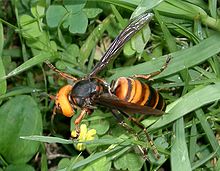Wildlife of Japan
The wildlife of Japan includes its flora, fauna and natural habitats. The islands of Japan stretch a long distance from north to south and cover a wide range of climatic zones. This results in a high diversity of wildlife despite Japan's isolation from the mainland of Asia. In the north of the country, there are many subarctic species which have colonized Japan from the north. In the south there are south-east Asian species, typical of tropical regions. Between these areas lies the temperate zone which shares many species with China and Korea. Japan also has many endemic species that are found nowhere else.
Fauna
Mammals

About 130 species of land mammal occur in Japan. The largest of these are the two bears. The Ussuri brown bear (Ursus arctos) is found in Hokkaidō where it plays an important role in the culture of the Ainu people. The Asian black bear (Ursus thibetanus) inhabits mountainous areas in Honshū, Kyūshū and Shikoku. Smaller carnivores include the red fox (Vulpes vulpes), raccoon dog (Nyctereutes procyonoides) and Japanese marten (Martes melampus). There are two wild cats in Japan: the leopard cat (Prionailurus bengalensis) of mainland Asia occurs on Tsushima Island while the Iriomote cat (Prionailurus iriomotensis) is unique to the island of Iriomote.
Grazing mammals include the sika deer (Cervus nippon), Japanese serow (Capricornis crispus) and wild boar (Sus scrofa). Among Japan's most famous mammals is the Japanese macaque (Macaca fuscata), the world's most northerly monkey.
Marine mammals include the dugong (Dugong dugon), finless porpoise (Neophocaena phocaeniodes) and Steller's sea lion (Eumetopias jubatus).
Birds

Over 600 species of bird have been recorded in Japan and more than 250 of these breed. A number of birds are endemic including the Japanese woodpecker (Picus awokera), copper pheasant (Syrmaticus soemmerringii) and Japan's national bird, the green pheasant (Phasianus versicolor). Several species are unique to the smaller islands including the Okinawa rail (Gallirallus okinawae), Izu thrush (Turdus celanops) and Bonin white-eye (Apalopteron familiare ). Most of the non-endemic birds are shared with China but a few originate in Siberia or south-east Asia.
Large numbers of migrant birds pass through Japan in spring and autumn including many waders. In winter, several sites are important for swans, geese and cranes.
Reptiles and amphibians

Japan has about 73 species of reptile of which nearly half are endemic. The mamushi (Gloydius blomhoffii) and the tiger keelback (Rhabdophis tigrinus) are the only venomous snakes in the main islands. The deadlier habus (Trimeresurus spp.) are found in the Ryukyu Islands. Sea turtles and sea snakes occur in warmer waters around southern Japan.
There are over 40 amphibian species including the Japanese giant salamander (Andrias japonicus), one of the world's largest amphibians. The Asiatic salamander family (Hynobiidae) is particularly well represented; many members of the family are found only in Japan.
Fish
Over 3000 different types of fish have been recorded in Japan. Important freshwater fish include the ayu (Plecoglossus altivelis), crucian carp (Carassius carassius) and common carp (Cyprinus carpio). The common carp is the ancestor of the well-known domestic koi carp. Small freshwater fish include the pale chub, Japanese chub (Nipponocypris sieboldii) and several species of bitterling including the endangered rosy bitterling.
Notable anadromous fish include 6 species of salmon represented by the chinook salmon, chum salmon, pink salmon, coho salmon, sockeye salmon, and the cherry salmon (which has several unique freshwater morphs in Japan). Chars in the genus Salvelinus are represented by the white-spotted char (including several unique varieties), Dolly Varden trout, and the endemic Kirikuchi char. Also present is the Japanese dace (Tribolodon hakonensis)
Important saltwater fish include the red sea bream (Pagrus major). Mudskippers are found in warmer areas while coral reefs in the Ryukyu Islands have many fish typical of tropical waters such as parrotfish and anemonefish. The little-known goblin shark (Mitsukurina owstoni) and frilled shark (Chlamydoselachus anguineus) have been recorded from deep waters off Japan.
Insects

Japan has around 300 kinds of butterfly including several of the mainly tropical milkweed butterflies in the Ryukyus. There are around 190 dragonflies including the primitive Epiophlebia superstes. Other well-known insects in Japan include cicadas, crickets and fireflies. Firefly viewing is a popular tourist attraction in some areas.
Molluscs
Flora

Around 5000 to 6000 species of plant occur naturally in Japan. The vegetation varies widely from subtropical forest in the south to coniferous forest in the north. In the subtropical zone, mangroves, cycads and tree ferns can be found. In the warm-temperate climate of Kyūshū, Shikoku and south-western Honshū, the dominant vegetation is broad-leaved evergreen forest with many oaks. In north Honshū and south-west Hokkaidō the climate is cool-temperate with broad-leaved deciduous trees including Japanese beech (Fagus crenata) and oaks like the konara (Quercus serrata). Conifers are dominant in much of Hokkaidō and in the mountains of central and northern Honshū with spruces and firs growing. In the highest mountains there is a zone of arctic-alpine plants including the low-growing Siberian dwarf pine (Pinus pumila).
Conifer plantations have replaced natural forest in many areas. Commonly grown trees include the hinoki cypress (Chamaecyparis obtusa), Japanese red pine (Pinus densiflora), Japanese black pine (Pinus thunbergii) and Japanese red cedar (Cryptomeria japonica). The last is Japan's tallest conifer reaching 40 metres in height.
Bamboo grows abundantly in Japan with around 400 to 500 different species including the dwarf bamboos known as sasa and the taller kinds called take which can reach 20 metres in height.
Many plants have been introduced to Japan from mainland Asia including important crops like rice and garden plants such as the chrysanthemum. Since the Meiji Restoration, increasing numbers of plants have come from Europe, North America and elsewhere. Native food plants include the water dropwort (Oenanthe javanica) and wasabi (Wasabia japonica).
See also
References
- Boeseman, M. (1947) Revision of the fishes collected by Burger and Von Siebold in Japan Leiden PDF
- Brazil, Mark A. (1991) The Birds of Japan, Christopher Helm, London
- Kodansha (1993) Japan: an illustrated encyclopedia, Kodansha, Tokyo.
